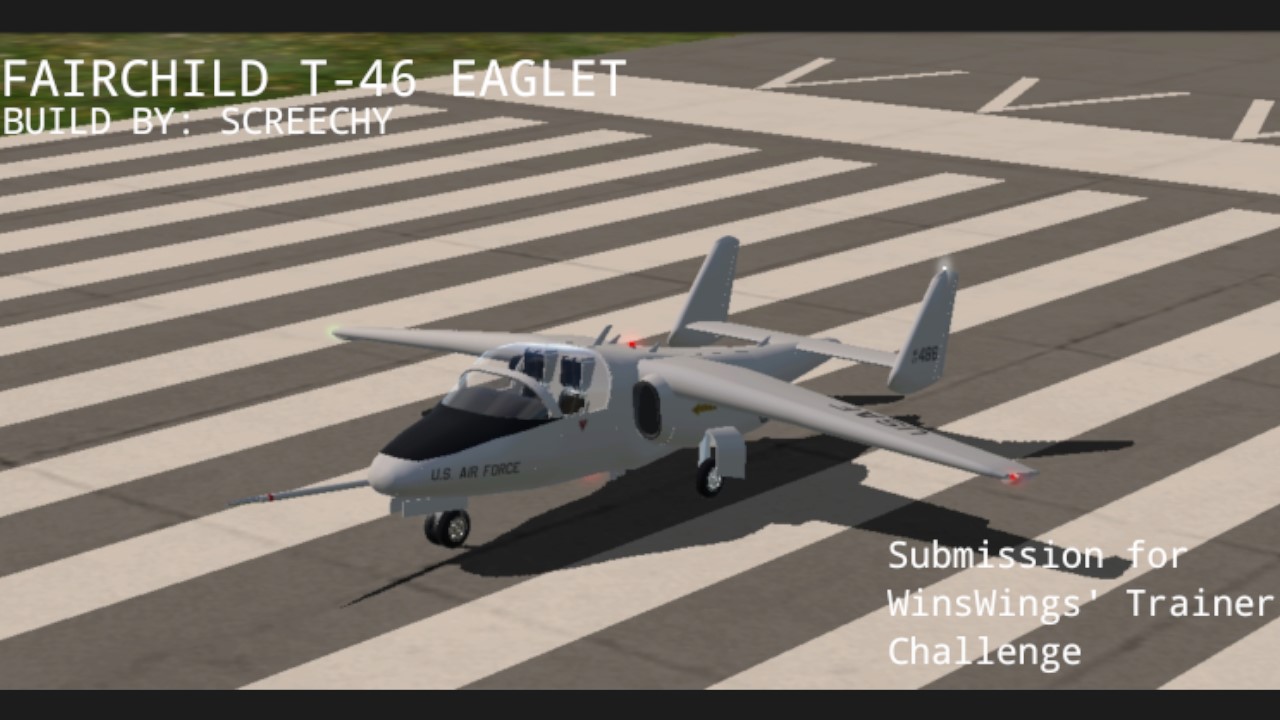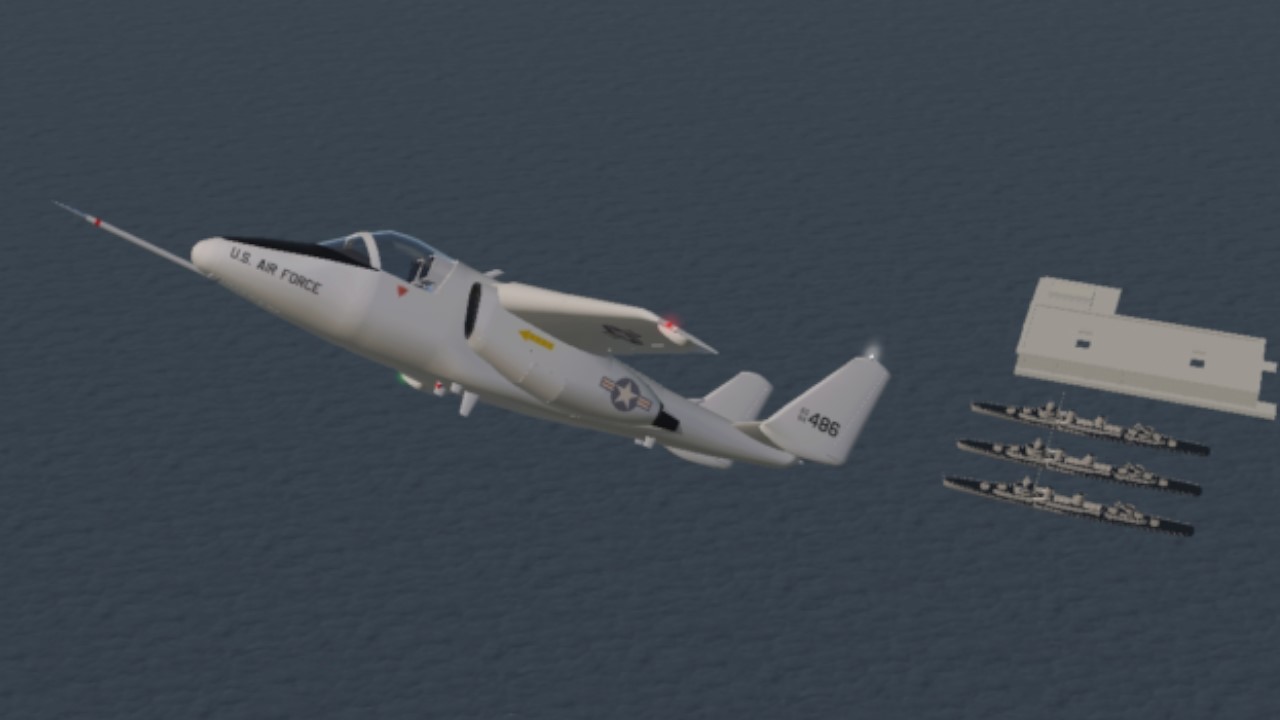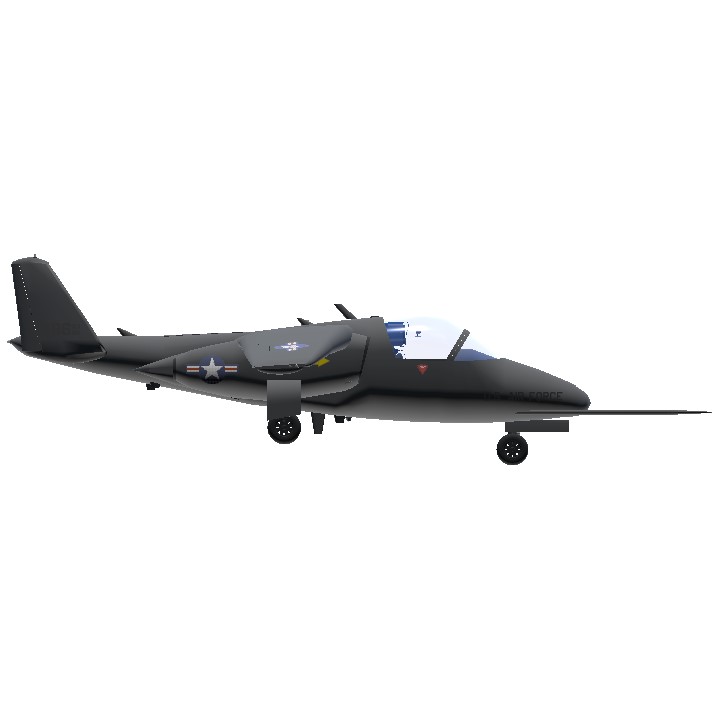Auto Credit Based on WinsWings's Trainer Challenge - 5/24 [CLOSED]
Hello everyone, i decided that WinsWings' Trainer Challenge is the right time for me to show my work
Today, its the infamous T-46 Eaglet, an aircraft actually enters production but unfortunately cancelled after three were built in the 80s.
Controls:
AG1 Canopy
AG2 Airbrakes
Info:
The Fairchild T-46 was an American light jet trainer aircraft of the 1980s. It was cancelled in 1986 with only three aircraft being produced.
Development:
The United States Air Force (USAF) launched its Next Generation Trainer (NGT) program to replace the Cessna T-37 Tweet primary trainer in 1981. Fairchild-Republic submitted a shoulder-winged monoplane with a twin tail, powered by two Garrett F109 turbofans and with pilot and instructor sitting side by side. Part of the rationale was an expectation of increasing levels of general aviation traffic. A pressurized trainer would permit training at higher altitude, leading to fewer restrictions on the new pilots.
In order to validate the proposed aircraft's design, and to explore its flight handling characteristics, Fairchild Republic contracted with Ames Industries of Bohemia, New York to build a flyable 62% scale version. Burt Rutan's Rutan Aircraft Factory in Mojave, California was contracted to perform the flight test evaluations, with test pilot Dick Rutan doing the flying. The scale version was known at Rutan as the Model 73 NGT, this flying on 10 September 1981. One requirement was for the aircraft to be able to go into a spin, but to also have easy recovery from the spin. This was demonstrated using the Model 73 NGT.
Fairchild's design, to be designated T-46, was announced winner of the competition on 2 July 1982, with the USAF placing an order for two prototypes and options for 54 production aircraft. It was planned to build 650 T-46s for the USAF by 1991.
The aircraft first flew on 15 October 1985, six months later than originally programmed date of 15 April. Costs had increased significantly during the development process, with the predicted unit cost rising from $1.5 million in 1982 to $3 million in February 1985. The 1985 Gramm–Rudman–Hollings Balanced Budget Act mandated spending cuts for the US government in an attempt to limit the national debt, and while testing did not reveal any major problems, Secretary of the Air Force Russell A. Rourke cancelled procurement of the T-46, while allowing limited development to continue. While attempts were made in Congress to reinstate the program, which resulted in the FY 1987 budget being delayed, an amendment was passed to the 1987 Appropriations Bill to forbid any spending on the T-46 until further evaluation of the T-46 against the T-37 and other trainers took place.
The project was cancelled a little more than a year later, for reasons that largely remain controversial[citation needed]. The T-46 was the last project of the Fairchild Republic Corporation, and after the program termination Fairchild had no more income. Without any new contracts and the NGT program cancelled, the company closed the Republic factory in Farmingdale, New York, bringing 60 years of Fairchild aircraft manufacturing to an end.
Design:
The aircraft itself featured a side-by-side configuration, a twin (or "H") tail (similar to the company's A-10), ejection seats, pressurization, and two turbofan engines. Had it gone into full production the NGT program called for 650 aircraft being built up to 1992. There was potential for some overseas sales as well, such as in the light ground attack role in addition to its role as a trainer.
Aircraft Characteristics (real life):
Crew: 2
Length: 29 ft 6 in (8.99 m)
Wingspan: 38 ft 7+3/4 in (11.779 m)
Height: 9 ft 11+3/4 in (3.042 m)
Wing area: 160.9 sq ft (14.95 m2)
Aspect ratio: 9.28:1
Airfoil: NASA LS(1)
Empty weight: 5,275 lb (2,393 kg)
Max takeoff weight: 6,962 lb (3,158 kg)
Fuel capacity: 200 US gal (170 imp gal; 760 L)
Powerplant: 2 × Garrett F109-GA-100 turbofans, 1,330 lbf (5.9 kN) thrust each
Maximum speed: 397 kn (457 mph, 735 km/h) at 25,000 ft (7,600 m)
Cruise speed: 333 kn (383 mph, 617 km/h) at 45,000 ft (14,000 m)
Range: 1,190 nmi (1,370 mi, 2,200 km)
Service ceiling: 46,500 ft (14,200 m)
Take-off distance to 50 ft (15 m): 1,520 ft (460 m)
Notes:
- This aircraft is fairly light and very, very delicate and sensitive, as it is.
- Im very sorry for the lack of cockpit controls for VR, as i can't find any pictures of this aircraft's cockpit as a reference.
- This is a submission for WinsWings' Trainer Challenge, I hope you enjoy this aircraft, as it was a bit hard to fly.
To anyone who downloaded, thanks!
Specifications
General Characteristics
- Predecessor Trainer Challenge - 5/24 [CLOSED]
- Successors 1 airplane(s) +42 bonus
- Created On Android
- Wingspan 36.3ft (11.1m)
- Length 35.6ft (10.8m)
- Height 10.6ft (3.2m)
- Empty Weight 7,307lbs (3,314kg)
- Loaded Weight 10,298lbs (4,671kg)
Performance
- Power/Weight Ratio 3.273
- Wing Loading 72.9lbs/ft2 (355.9kg/m2)
- Wing Area 141.3ft2 (13.1m2)
- Drag Points 7467
Parts
- Number of Parts 229
- Control Surfaces 8
- Performance Cost 1,128






@WinsWings Thanks
congratulation for the challenge - I have posted the prizes
@WinsWings thanks
If the sk60b had a baby with a different plane:
Ps-fun plane specially weaponizing it XD
Great job. Awesome